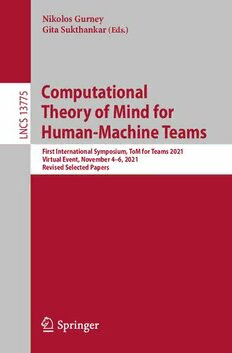
Computational Theory of Mind for Human-Machine Teams: First International Symposium, ToM for Teams 2021, Virtual Event, November 4–6, 2021, Revised Selected Papers PDF
Preview Computational Theory of Mind for Human-Machine Teams: First International Symposium, ToM for Teams 2021, Virtual Event, November 4–6, 2021, Revised Selected Papers
Nikolos Gurney Gita Sukthankar (Eds.) Computational 5 7 7 Theory of Mind for 3 1 S C Human-Machine Teams N L First International Symposium, ToM for Teams 2021 Virtual Event, November 4–6, 2021 Revised Selected Papers Lecture Notes in Computer Science 13775 FoundingEditors GerhardGoos KarlsruheInstituteofTechnology,Karlsruhe,Germany JurisHartmanis CornellUniversity,Ithaca,NY,USA EditorialBoardMembers ElisaBertino PurdueUniversity,WestLafayette,IN,USA WenGao PekingUniversity,Beijing,China BernhardSteffen TUDortmundUniversity,Dortmund,Germany MotiYung ColumbiaUniversity,NewYork,NY,USA Moreinformationaboutthisseriesathttps://link.springer.com/bookseries/558 · Nikolos Gurney Gita Sukthankar (Eds.) Computational Theory of Mind for Human-Machine Teams First International Symposium, ToM for Teams 2021 Virtual Event, November 4–6, 2021 Revised Selected Papers Editors NikolosGurney GitaSukthankar UniversityofSouthernCalifornia UniversityofCentralFlorida LosAngeles,CA,USA Orlando,FL,USA ISSN 0302-9743 ISSN 1611-3349 (electronic) LectureNotesinComputerScience ISBN 978-3-031-21670-1 ISBN 978-3-031-21671-8 (eBook) https://doi.org/10.1007/978-3-031-21671-8 ©TheEditor(s)(ifapplicable)andTheAuthor(s),underexclusivelicense toSpringerNatureSwitzerlandAG2022 Thisworkissubjecttocopyright.AllrightsarereservedbythePublisher,whetherthewholeorpartofthe material is concerned, specifically the rights of translation, reprinting, reuse of illustrations, recitation, broadcasting, reproduction on microfilms or in any other physical way, and transmission or information storageandretrieval,electronicadaptation,computersoftware,orbysimilarordissimilarmethodologynow knownorhereafterdeveloped. Theuseofgeneraldescriptivenames,registerednames,trademarks,servicemarks,etc.inthispublication doesnotimply,evenintheabsenceofaspecificstatement,thatsuchnamesareexemptfromtherelevant protectivelawsandregulationsandthereforefreeforgeneraluse. Thepublisher,theauthors,andtheeditorsaresafetoassumethattheadviceandinformationinthisbookare believedtobetrueandaccurateatthedateofpublication.Neitherthepublishernortheauthorsortheeditors give a warranty, expressed or implied, with respect to the material contained herein or for any errors or omissionsthatmayhavebeenmade.Thepublisherremainsneutralwithregardtojurisdictionalclaimsin publishedmapsandinstitutionalaffiliations. ThisSpringerimprintispublishedbytheregisteredcompanySpringerNatureSwitzerlandAG Theregisteredcompanyaddressis:Gewerbestrasse11,6330Cham,Switzerland Preface Peoplerelyonaskillcommonlyreferredtoastheoryofmind(ToM)toinferthemental states,e.g.beliefs,ofothers.ItiswidelybelievedthatToMinferenceisakeyelementto thealchemythathumansemploywhentheymakepredictionsaboutotheragents.Crit- ically, ToM inferences, as well as the associated models and predictions, can become extremelycomplexwhenmadeinteamsettings.Thisisparticularlytruewhenahuman mustformn-levelbeliefsaboutotheragentsandtheirinteractions.Extensiveresearch positsthathigh-performingteamsnaturallyalignkeyaspectsoftheirindividualmodels, includingsocialmodelsbasedonToM,tocreatesharedmentalmodelsoftheirenviron- ment,equipment,strategies,and,ofcourse,therelevantagents.Thus,ToMandtheability tocreatesharedmentalmodelsarekeyelementsofhumansocialintelligence.Together, thesetwoskillsmayformthebasisforhuman collaboration atallscales,whether the settingisaplayingfieldoramilitarymission.Itfollowsthatartificialintelligence-based machineswouldbenefitfromtheabilitytomodelhumanToMandsharedmentalmodels. Artificialintelligence(AI)technologieshavemadelittleprogressinunderstanding themostimportantcomponentoftheenvironmentsinwhichtheyoperate:humans.This lack of understanding stymies efforts to create safe, efficient, and productive human- machineteams.Thisvolumecuratesstate-of-the-art,peer-reviewedresearchfromcom- puterscience,cognitivescience,andsocialscienceexaminingthedevelopmentofarti- ficialintelligencesystemscapableoftheoryofmind,exhibitingsocialintelligence,and using these skills in human-machine teams—i.e. artificial social intelligence (ASI). TOMforTeams2021received22submissions.Eachsubmissionreceivedaminimum ofthreereviewsinasingle-blindpeerreviewprocess.Intheend,11paperswereaccepted forpublicationwithminorrevisions(50%)and9acceptedwithmajorrevisions(40.9%); intotal,14paperscompletedthereviewprocessandwereincludedinthisvolume.The 2021editionofthisconferencewasheldasanvirtualevent. SectionI:TheoryofMind Theoryofmind(ToM)isatermusedtoreferencetheabilitytoinferthementalstates, thatis,beliefs,desires,emotions,etc.,ofothersandthenusethoseinferencesforother cognitivepurposes.Moderneffortstounderstandthephenomenonarecommonlytraced backtoseminalworkinthesociallivesofprimates[3](whichiswherethetermtheoryof mind tookhold)andhowsituationalfeaturesinfluencesocialperception[2].Thatdoes notmeantheideaisamoderninvention.Theideathatothershavedistinctmindsthatwe can perceive and use as information is littered throughout philosophy: Descartes tried toestablishamind-bodydistinctionforthispurposeduringtheRenaissance,Platoused thehorsesandchariotanalogyinthePhaedrustodescribeconflictinginternaldrivesand howtheyinfluencepeople,andtheancientBuddhistphilosopherVasubandhudescribed thebasicfactorsofexperienceandbehaviorinanefforttouncovertheinternalstatesof others. vi Preface The first section of this volume presents foundational surveys that provide impor- tant background on computational ToM. Modern theories about ToM are reviewed in the chapter Operationalizing Theories of Theory of Mind: A Survey, which discusses competingtheories,theirimplementationincomputationalagents,andwhatcomputer scientists and psychologists can collectively learn from doing so. The chapter Knowl- edgeofSelfandOtherWithinaBroaderCommonsenseSettingdigsdeeperwithalook attheknowledgerepresentationsandreasoningabilitiesthatanagentinateamneedsin orderforittohaveToM.Thelastchapterinthissection,ConstructivistApproachesfor ComputationalEmotions:ASystematicSurvey,introducesreaderstothreeapproaches tomodelingemotions,acoreelementofToM,andtheirrepresentationintheaffective computingliterature. SectionII:MethodologicalAdvances Asimportantasclarifyingwhatisbeingstudiedisestablishingbestpracticesfor how itisstudied.Studyinghowpeopleinteractwithintelligentmachineshasarich,storied history. One of the earliest and most famous examples paired people with a natural language processing program, ELIZA, which ran a script that simulated a Rogerian psychotherapist(itsimplyparrotedwhatpeoplesaid)[4].Notonlydidpeoplebelieve that the program was intelligent, they anthropomorphized it.Joseph Weizenbaum, the authoroftheprogram,reflectingonitintheintroductiontohisbooksaid[5]: I was startled to see how quickly and how very deeply people conversing with [ELIZA]becameemotionallyinvolvedwiththecomputerandhowunequivocally theyanthropomorphizedit. It seemed to him that people were forming an emotional relationship with the machine,treatingitasifithadamindandunderstoodtheirplight—i.e.theyassumedit wasanASI. In the half century since Weizenbaum created ELIZA and Premack and Woodruff popularizedthetermToM,vastamountsofefforthasgoneintodevelopingartificialintel- ligenceandimprovingourunderstandingofsocialcognition.SectionIIopensupwith Social Cognition Paradigms ex Machinas, which surveys experimental methods from psychologyandcognitivescienceandtranslatesthemforAI-settings.Thissurveyisfol- lowedbyfourchapters,eachintroducingastate-of-the-arttechnologyforstudyingand developingASI.EvaluatingArtificialSocialIntelligenceinanUrbanSearchandRes- cueTaskEnvironmentintroducesasimulatedUSARtestbed,datafromteamsofhuman participantsperformingsearchandrescuetasks,andevaluationofASIsperformingpost hoc interpretation of the data. The next chapter, Modular Procedural Generation for VoxelMaps,introducesanewtechnologydevelopedtodrasticallysimplifythecreation ofvirtualenvironments,suchastheoneintheprecedingchapter,whileensuringthatthe environmentisreadilyprocessedbyartificialintelligence.Animportantquestionwhen developingnewmethodsandapproachestostudyinganyteamingtask,butparticularly human-machineones,iswhatroledoestaskcomplexityplay?TaskComplexityandPer- formanceinIndividualsandGroupsWithoutCommunicationasksthisquestionandpro- videsrelevant,guidinginsightstotheASIresearchcommunity.Thesectioncloseswith Preface vii DevelopmentofEmergentLeadershipMeasurement:ImplicationsforHuman-Machine Teams,whichtacklesoneofthebiggestchallengesinASIdevelopment:digestingnatural languageandusingittoidentifyemergentrolesinhuman-machineteams. Section III: Translating and Modeling Human Theory of Mind forASI Thissectionpresentsworkaddressingthemeatofthetopic:endowingASIwithhuman- like social intelligence. This is no small task, if for no other reason because there is considerable disagreement in the cognitive science community about what exactly is ToM[1].Aperusalofthefirsttwosectionsunderscoresthisreality. EachchapterinthissectiontacklesadifferentaspectofAIrepresentingthethoughts andbeliefsofhumanagents.ThesectionopenswithShouldAgentsHaveTwoSystemsto TrackBeliefsandBelief-LikeStates?,whichpositsanewtakeonhowtoachievehuman- likeToMwithoutrelyingonacomplex,dual-systemmodel(onesystembeingefficient butinflexible,theothercumbersomeandflexible).Thenextchapter,SequentialTheory ofMindModelinginTeamSearchandRescueTasks,introducesastate-of-the-artcom- putationalmodelforASIthatiscapableofinferringToMstatesfromnaturallanguage. OneofthebiggestchallengesfacedbyASIresearchersisstayingtruetothecognitive modelsofToMwhileusingthebesttechnologyavailable:IntegratingMachineLearn- ingandCognitiveModelingofDecisionMakingdemonstratesthatahybridapproachto modelingToM,whichimplementsbothcognitivemodelsandmachinelearningmodels, isnotonlyfeasible,butcapableandefficient.ThesectionwrapsupwithOvergenerality from Inference in Perspective-Taking, which establishes important perspective taking boundariesforcomputationalToM. SectionIV:ToolsforImprovingASI Thisvolumecloseswithtwochaptersintroducingstate-of-the-artapproachestoachiev- inghuman-levelskillsthatareessentialtoToMcapabilities.UsingFeaturesatMultiple TemporalandSpatialResolutionstoPredictHumanBehaviorinRealTimeshowsthat integratingalow-resolutionapproachtodatainterpretationalongwiththetypicalhigh- resolutionapproachcanproducesignificantpredictionaccuracy(i.e.,betterToM).The closingchapter,RouteOptimizationinServiceofaSearchandRescueArtificialSocial Intelligence Agent, presents a state-of-the-artlearning pipeline designed to aid ASI in understandingitsenvironment.Specifically,itempowerstheASItoassessthequality of routes that a person may follow in an environment which the ASI can later use in reasoningabouttheperson’sbeliefsaboutthetaskandenvironment. ClosingRemarks The mental representations that we maintain of what is happening in the minds of others is a core aspect of human cognition. As set out in the opening chapter of this volume,thescientificcommunityhasyettofullydescribethisveryhumanexperience viii Preface or replicate it in machines. Doing so is, arguably, one of the tallest hurdles along the pathtoartificialgeneralintelligence.Theauthorsrepresentedinthisvolumealsoholda strongconvictionthatASIisacriticalelementtohelpinghumansmorefullyacceptand integratecomputationalagentsintoteamsaswellastheirlivesmoregenerally.Thework presentedhereinrepresentsourcollectiveeffortstobetterunderstandToM,developAI withToMcapabilities(ASI),andstudyhowtointegratesuchsystemsintohumanteams. AcknowledgementsPartoftheeffortdepictedissponsoredbytheDefenseAdvanced ResearchProjectsAgency(DARPA)undercontractnumberW911NF2010011,andthat thecontentoftheinformationdoesnotnecessarilyreflectthepositionorthepolicyof theUSGovernmentortheDefenseAdvancedResearchProjectsAgency,andnoofficial endorsementsshouldbeinferred. October2022 NikolosGurney DavidV.Pynadath GitaSukthankar VolkanUstun References 1.Gurney,N.,Marsella,S.,Ustun,V.,Pynadath,D.:Operationalizingtheoriesoftheoryofmind: asurvey.InPress,AAAIFallSymposium(2022) 2.Heider,F.,Simmel,M.:Anexperimentalstudyofapparentbehavior.Am.J.Psychol.57(2), 243–259(1944) 3.Premack,D.,Woodruff,G.:Doesthechimpanzeehaveatheoryofmind?BehavioralBrainSci. 1(4),515–526(1978) 4.Weizenbaum,J.:Eliza—acomputerprogramforthestudyofnaturallanguagecommunication betweenmanandmachine.Commun.ACM9(1),36–45(1966) 5.Weizenbaum,J.:Computerpowerandhumanreason:fromjudgmenttocalculation(1976) Organization GeneralChair GitaSukthankar UniversityofCentralFlorida,USA ProgramCommitteeChairs JoshuaElliott DARPA,USA NikolosGurney UniversityofSouthernCalifornia,USA GuyHoffman CornellUniversity,USA LixiaoHuang ArizonaStateUniversity,USA EllynMaese Gallup,USA NgocNguyen CarnegieMellonUniversity,USA KatiaSycara CarnegieMellonUniversity,USA AdditionalReviewers PavanKantharaju MuhammadJunaidKhan JiHyunJeong ShengnanHu DavidGrethlein RamyaAkula RhyseBendell DavidGrethlein VericaBuchanan JaredFreeman LydiaTapia SureshJayaraman PetaMasters SebastianSardina ChristopherCorral AshishAmresh ChaseMcDonald PauloRicardodaSilvaSoares KobusBarnard SaritAdhikari MyounghoonJeon YunKang DeepayanSanyal MattLaw DuyNhatPhan MattWood JosephLyons StephenCauffman YunKang
